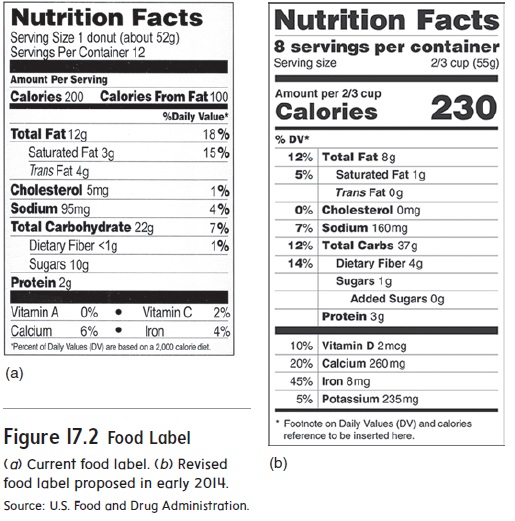Chapter: Essentials of Anatomy and Physiology: Nutrition, Metabolism, and body Temperature Regulation
Daily Values - Human Nutrition
Daily Values
Daily Values appear on food labels to help consumers plan ahealthful diet and to minimize confusion. However, not all pos-sible Daily Values are required to be listed on food labels. Daily Values are based on two other sets of reference values—Reference Daily Intakes and Daily Reference Values:
· Reference Daily Intakes (RDIs) are based on the 1968 RDAsfor certain vitamins and minerals. RDIs have been set for four categories of people: infants, toddlers, people over 4 years of age, and pregnant or lactating women. Generally, the RDIs are set to the highest 1968 RDA value of an age category. For example, the highest RDA for iron in males over 4 years of age is 10 mg/day and for females over 4 years of age is 18 mg/day. Thus, the RDI for iron is set at 18 mg/day.
· Daily Reference Values (DRVs) are set for total fat,saturated fat, cholesterol, total carbohydrate, dietary fiber, sodium, potassium, and protein.
The Daily Values appearing on food labels are based on a 2000-kcal reference diet, which approximates the weight mainte-nance requirements of postmenopausal women, women who exercise moderately, teenage girls, and sedentary men (figure 17.2). On large food labels, additional information is listed based on a daily intake of 2500 kcal, which is adequate for young men.

The Daily Values for energy-producing nutrients are determined as a percentage of daily kilocaloric intake: 60% for carbohydrates, 30% for total fats, 10% for saturated fats, and 10% for proteins. The Daily Value for fiber is 14 g for each 1000 kcal of intake. The Daily Values for a nutrient in a 2000 kcal/day diet can be calculated on the basis of the recommended daily percentage of the nutrient and the kilocalories in a gram of the nutrient. For example, carbohydrates should constitute 60% of a 2000 kcal/day diet, or 1200 kcal/day (0.60 × 2000). Because there are 4 kilocalories in a gram of carbo-hydrate, the Daily Value for carbohydrate is 300 g/day (1200/4).
The Daily Values for some nutrients are the uppermost limit considered desirable because of the link between these nutrients and certain diseases. Thus, the Daily Values for total fats are less than 65 g; saturated fats, less than 20 g; and cholesterol, less than 300 mg because of their association with increased risk of heart disease. The Daily Value for sodium is less than 2400 mg because of its association with high blood pressure in some people.
For a particular food, the Daily Values are used to calculate thePercent Daily Value (% Daily Value) for some of the nutrientsin one serving of the food (figure 17.2). For example, if a serving of food has 3 g of fat and the Daily Value for total fat is 65 g, then the % Daily Value is 5% (3/65 = 0.05, or 5%). The Food and Drug Administration (FDA) requires % Daily Values to be on food labels, so that the public has useful and accurate dietary information.
In early 2014, the FDA proposed a major revision of food nutri-tion labels. The newly proposed nutrition labels will have calorie counts displayed more prominently, representing more reasonable serving sizes (Figure 17.2b). Manufacturers will also be required to list the amount of added sugar on the nutrition label, to assist the consumer in making better choices about total sugar intake, which has been linked to the current increase in obesity in the United States. Saturated fat and trans fat information will also be included, but the “Calories from Fat” on the old label will no longer be included. This reflects the modern view of nutritionists that the types of fats we ingest are more important than the amount. Once the new food label has been approved, manufacturers will have to include the revisions on most packaged foods within two years.their weight on a 2000 kcal/day diet, the total of the % Daily Values for each of these nutrients should be no more than 100%. However, for individuals consuming more or fewer than 2000 kcal per day, the total of the % Daily Values can be more or fewer than 100%. For example, for a person consuming 2200 kcal/day, the total of the % Daily Values for each of these nutrients should be no more than 110% because 2200/2000 = 1.10, or 110%.
When using the % Daily Values of a food to determine how the amounts of certain nutrients in the food fit into the overall diet, the number of servings in a container or package needs to be considered. For example, suppose a small (2.25-oz) bag of corn chips has a % Daily Value of 16% for total fat. A person might suppose that eating the bag of chips accounts for 16% of total fat for the day. The bag, however, contains 2.5 servings. All the chips in the bag account for 40% (16% × 2.5) of the maximum recommended total fat.
Related Topics